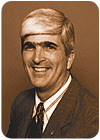
Hot Water Changes
So, what changes are being missed by the engineering community? Perhaps the biggest change is to the hot water requirements. The control of hot water has been added for many fixtures that were previously not addressed.All bathtubs (without a shower) must have a thermostatic mixing valve. That includes all whirlpool bathtubs and roman tubs. The valve must conform to ASSE 1070. The older styles of fill valve are no longer permitted. Furthermore, if it is only a bathtub, you cannot use a pressure balancing valve.
If the tub has a shower, either a pressure balancing or thermostatic mixing valve must be installed. The valve would have to comply with either ASSE 1016 or ASSE 1070.
The hot water control requirements are designed to reduce the incidence of scalding in a bathtub. The maximum temperature permitted for a bathtub is 120°F. Although this is too high a temperature to take a bath, the 120°F is based on a cast iron tub being a major heat sink and the reheating of a bath requiring warmer water.
It should be noted that a temperature of 120°F is below the temperature where immediate scalding occurs. There is time for a person to respond and get out of the tub without damage to the skin.
An even bigger change regarding hot water is public lavatories. All public lavatories must have thermostatic mixing valves. Again, the standard applicable to these valves is ASSE 1070. Some engineers have been interpreting the lavatory requirements as only being applicable to handicap-accessible lavatories. But the change to the plumbing codes made the requirements applicable to all public lavatories.
If you have a building with a bidet, the hot water control requirements apply to a bidet as well. The valve must conform to ASSE 1070. The maximum temperature permitted is 110°F. The lower temperature limitation is based on the application of the fixture. Unlike a bathtub, a bidet does not need high temperatures. Plus, a bidet is washing sensitive areas of the body.
Again, these requirements appear in all three codes. While the wording is different, the requirements are the same.
At the current time, there is a considerable additional cost for ASSE 1070 fill valves and lavatory faucets. As more products enter the market, expect prices to drop.

Grab Bars
The remaining change that has surprised the plumbing engineering community is the new grab bar requirement for handicap plumbing fixtures. The 2006 International Building Code makes reference to the 2003 ANSI/ICC A117.1 standard for accessible building requirements.ANSI/ICC A117.1 has added grab bars for water closets and showers. A vertical grab bar is now required on the sidewall of the water closet compartment. The grab bar must be located in the front section of the sidewall. This side grab bar is intended to assist those that may not be confined to a wheelchair, but still require assistance.
In shower compartments, a vertical grab bar is required on the same wall as the shower valve. The grab bar must be located at the entry into the shower.
Other changes to the ANSI/ICC A117.1 standard include the addition of child-size fixture requirements. The ranges in dimension are designed to accommodate the very young up through grade school age.
The requirements for accessible urinals have changed. When only one urinal is installed, it can be installed at the standard height. However, when there are two or more urinals, at least one must be at an accessible height. It is understood that urinals installed at accessible heights are used by little boys, not individuals confined to a wheelchair.
Finally, the distance from the sidewall to the centerline of the water closet was modified to 16-18 inches. This allows a tolerance for the installation of a water closet.
For ambulatory water closets, the distance is a range of 17-19 inches to the sidewall. Of course, the difference is that for an ambulatory compartment, the two sidewalls are 36 inches apart. Hence, the difference in the tolerances to the centerline of the water closet.
ASPE Presidency
I have received many notes of congratulation from the readers since assuming the position of president of the American Society of Plumbing Engineers (ASPE). I want to say thank you for your kind words.Yes, it is a lot of work. Yes, it takes a lot of time. Yes, I am enjoying every minute of it. I hope that answers many of the questions that have come my way.
My publisher has been kind enough to allow me to occasionally put in a plug for ASPE, so I will do so here. I need you to be involved. If you are not a member, please join. The application for membership to ASPE can be found atwww.aspe.org.
Committees are currently being formed and we need volunteers. If you are interested in helping out, send me an e-mail. I will add your name for consideration on a committee.
I assure you that I will work very hard on your behalf. We need to increase our recognition and promote the high caliber of individuals in the profession. You can help me achieve that goal.
Finally, I wish you and your family the very best this holiday season. Happy holidays and enjoy the New Year.
